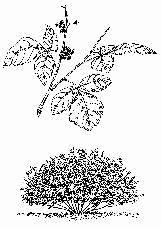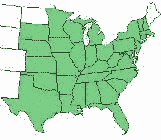



fragrant suamc
Rhus aromatica
Fragrant sumac is a small, deciduous shrub with a mature height of 5 to 7 feet and 6 to 10 feet wide. An excellent shrub for wildlife, it is also very useful for landscaping. It has yellow flowers in the spring. The red drupes (berries) are attractive and provide good wildlife food. The leaves have the potential to turn orange to red to purple in the fall, especially on “lighter” soils. Several cultivars are available with “Gro-low” and “Konza” staying under 2 feet high making them good building foundation plants.
Native Range:

Plant illustration by Dale Larison, Missouri Department of Conservation
Range map modified from PLANTS National Database Web site - http://plants.usda.gov/
ISA Certified Arborist Scholarships Offered
In an effort to increase the number of certified commercial arborists in rural areas, the International Society of Arboriculture (ISA) in cooperation with the USDA Forest Service is offering a scholarship opportunity for municipal and commercial arborists.
The scholarship will cover the cost of ISA and Chapter membership for one year, the ISA Certified Arborist certification exam, and a local or regional training workshop (including the ISA Certification Study Guide) to help the arborist prepare for the exam.
In return for the scholarship, the arborist must provide 80 hours of community service over a two year period in the community or communities where he or she works. This service could be training sessions to educate the public about proper tree care or volunteer tree work to serve as an example of good arboricultural practice.
This scholarship is only available to arborists residing and working in Missouri. All applicants must meet the requirements for certification. The ISA Certified Arborist application can be downloaded at www.isa-arbor.com/certification/resources/certapp.pdf. Please submit the Arborist application along with the scholarship application (download at: www.geocities.com/rocksandtrees/thestump/oct2004/isascholarshipapplication.pdf) to Justine Gartner by October 31, 2004. DO NOT SEND ANY MONEY WITH APPLICATIONS. Preference will be given to arborists who work in communities outside the St. Louis, Kansas City and Springfield metropolitan area.
This is a unique opportunity which is not likely to be offered in future years. If you are interested and have any questions, do not hesitate to contact Justine Gartner (573-522-4115 ext 3116, Justine.Gartner@mdc.mo.gov).
Storm Preparedness and Response Workshop
Natural disasters in Missouri include floods, tornadoes, high-velocity winds, and ice storms. These events can strike large cities and small communities alike, creating havoc and unparalleled costs. Preparing for these natural disasters is critical to minimize the impact in your community.
This workshop provides practical, up-to-date management and planning information to help minimize damage to trees and maximize the safety of your citizens. Designed for city managers, emergency management directors, planners, engineers, public works professionals, and foresters, it will include expert advice and helpful tips on how to prepare for storms, how to respond when the event occurs, and how to recover from the subsequent loss of vegetation.
The workshop will be held November 4, 2004 from 9 AM to 4 PM at the Farm Credit Service Office, 3200 Highway 61 north, Hannibal, MO. A $10.00 fee to cover lunch, refreshments and other costs is required with registration which is due on October 28, 2004. I will be attending and can take a few passengers. Let me know if interested in a ride. Contact Forest ReLeaf of Missouri with your questions at 888-473-5323 or email Moreleaf@anet-stl.com. Download the registration form at: www.geocities.com/rocksandtrees/thestump/oct2004/2004stormworkshop.pdf.
Winter Tree Care
Winter is a time when trees generally take a break and go dormant or into a period of reduced activity. This does not mean that they do not have needs. Winter can be tough on trees. With a little help from you, trees can have an easier time during the winter. Every tree is different and so its exact needs also will be different. Fortunately, there are several things you can do that will help most trees get through with flying colors.
Mulch: All trees will benefit from properly placed mulch. Mulch holds moisture and insulates the soil moderating the temperature fluctuations below it. Freezing and thawing can trick a tree and occasionally get it to start spring bud break too early. Mulch depth depends on the type of mulch used. The MDC mulching handout is available on-line (www.mdc.mo.gov/documents/forest/urban/F00111.pdf) or from my office.
Prune: Proper pruning of trees can improve the structure and heath of a tree. Not every tree needs pruned every year! I prefer winter pruning because bacteria, fungus, and insect pests are dormant and less likely to attack a fresh wound. The MDC pruning handout is available on-line (www.mdc.mo.gov/documents/forest/pruning_guide.pdf) or from my office.
Wrap: Thin bark trees are at risk of developing sunscald. It occurs when the trunk freezes during the night, then a portion warms and thaws out during the day, then quickly re-freezes the next night. As the water in the stem turns to ice, it ruptures the cells of the tree and kills them. The result is dead portions of the trunk, usually on the southwest side. Wrapping trees with thin bark up to the lowest limb with paper tree wrap or burlap will shade the trunk and reduce the chance of sunscald. Remove the wrap in the spring.
Water: Even during the winter conifers will transpire and the soil can dry out. Thus the soil will need to have itís water replenished during the winter. This will help reduce extreme temperature changes in the soil, keep roots moist, and provide water for transpiring trees. When the ground is thawed and the soil is dry, water the area around your trees. The MDC watering handout is available on-line (www.mdc.mo.gov/documents/forest/3-122.PDF) or from my office.
With a little work, your trees will respond well and be ready for spring.